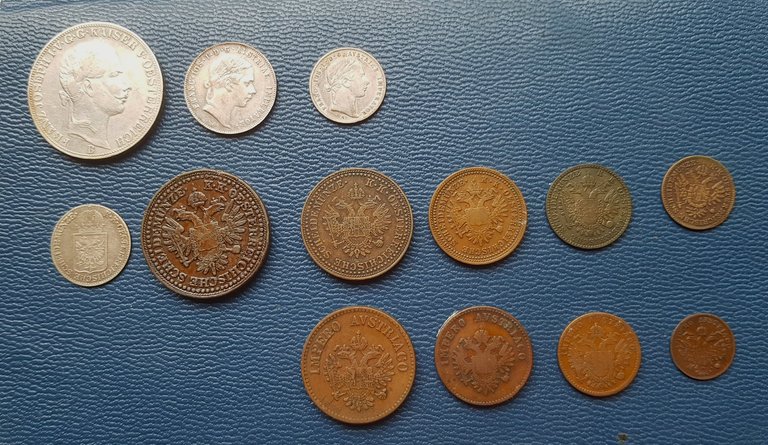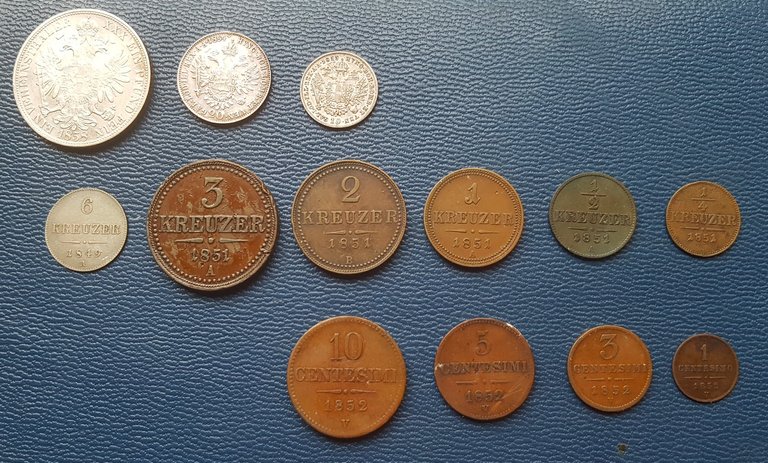How I Collect Coins

In a way, it is easy to collect contemporary investment coins. You simply order them from a dealer. You get them new, undamaged, for the price of silver and some margin or tax.
Collecting older coins is a bit more complicated. Some of them are unique and not for sale. Others are available only occasionally and usually at exorbitant prices. So it takes time.
I used to physically visit stock exchanges most often. With the spread of the internet, I started to follow various traders, auction sites and so on. That's not to say that I don't occasionally look around garage sales, flea markets and junk shops.
Today I am showing a certain series of coins that were valid in one place at one time. How long did it take me to create it? About 40 years. The series is not complete, of course.
I'm a collector of coin types. There are also collectors of individual years and mints. Not even the richest person in the world could build a truly complete coin collection unless they set a very limited goal to begin with.
Every collector has a lifelong task ahead of him that he will never be able to accomplish, but he will keep trying. For me, it is an enjoyable pastime that at the same time will someday be quite rewarding for my son.

And now to the individual coins.
Federal Thaler (Monetary Association of Austria and Bavaria 1753-1857, 1 thaler = 120 kreutzers), 1858, diameter 33 mm, weight 18.518 g of silver, purity 900/1000
20 Kreutzer, 1854, diameter 22 mm, weight 4.32 g of silver, purity 900/1000
10 Kreutzer, 1853, diameter 18 mm, weight 2.16 g of silver, purity 900/1000
Copper coins
Largest 3 Kreutzer, 1851, diameter 30 mm, weight 16.4 g of copper
Smallest 1/4 Kreutzer, diameter 17.5 mm, wight 1.37 g of copper
To the Italian coins. Between 1815 and 1859, or 1866, the Austrian Empire was dominated by the Kingdom of Lombardy-Benatia, for which special coins were minted.
Besides all the national, social, religious and other problems, there was also a practical mathematical problem. Italy was occupied by France during the Revolutionary and Napoleonic wars, which introduced the metric system. Austria adopted the metric system only later.
The way it worked was that 1 krejcar was equivalent to 5 centisimi. The Italian silver coins, the scudo and the lira, did not correspond to the Austrian federal toleers. There were also gold coins. Austria had ducats and federal crowns, Italy had sovrans. A desperate mess.
No wonder the Italians tried to create their own state with their own currency. They often staged revolutions, later invented the anarchist movement and resorted to assassinations. One of those assassinations was that of Empress Elizabeth of Austria.
I acknowledge that the monetary system was not the main driver of the Italian national liberation movement!
Thank you for reading and for any support. I have no idea when I'll write something again. I'm repeatedly convincing myself that planning is pointless for me.
Post voted 100% for the hiro.guita project. Keep up the good work.
New manual curation account for BEE and Cent
Thank you very much.
You received an upvote of 100% from Precious the Silver Mermaid!
Thank you for contributing more great content to the #SilverGoldStackers tag.
You have created a Precious Gem!
I collect whatever comes my way I try to not get suckered into trying to complete a set or find something particular!BBH
@trautenberk! Your Content Is Awesome so I just sent 1 $BBH (Bitcoin Backed Hive) to your account on behalf of @bitcoinman. (8/50)
I understand. I have already started differently and I continue to do so.
!HUG
I sent 1.0 HUG on behalf of @trautenberk.
(1/1)
Nice coins!
Thank you.
Very good way to collect by type, it adds a method to the madness. I kind of collect whatever I get a good deal on anymore, so absolutely no method to my madness! You have a great collection, I keep missing your posts for some reason!
!BBH
@trautenberk! Your Content Is Awesome so I just sent 1 $BBH (Bitcoin Backed Hive) to your account on behalf of @thebighigg. (12/50)
Thank you.
That's another remarkable insight to your collection. Thank you for that! Do you have any hint on not going after plagiarism and finding the real thing at good price? And do you sometimes sell coins out of any reason like doubles?
!invest_vote
By plagiarism, you mean getting fake replicas instead of 'real' oldies?.. quite hard nowadays, until you are a good expert yourself. (And even an expert can be fooled.... especially when you have to obtain stuff via internet).
Ok thanks, I see. Yes, that's what I meant. So even already being an expert does not necessarily help? Experience certainly does. And gut feeling. So tell me, do you sometimes sell coins for some reason, e.g. duplicates? Prospects are suspicious then, don't they?
!invest_vote
No, I am not a seller and not a collectioneer, I'd rather a conoisseur and hoarder. My wife and me have a little joint collection of random stuff (including - lol - one fake replica of gold tzar rouble from 1896). A few I found on the streets, a few I obtained at flea market. I love these coins as oldies, and dont want to sell them, would love to get more (especially without sufficient investments). Have no idea what will my grandchildren will do with all this stuff :D
!BEER
Variously in Europe, I have encountered trustworthy-looking old men at flea markets organised for tourists, selling all Chinese replicas without labelling them as such. Since I have been collecting coins for a very long time, I rely on my gut feeling. But I also get it wrong sometimes.
At one point I was thinking about collecting the replicas instead, buying them directly at China via aliexpress. I searched thru the sites and considered that replicas differ - and it would be not easy to get a good copy... I opted out of spending money for several tries, with no guaranteed result of getting a good copy instead of shit. So I never tried... I am still in love with the old coins, but... seems nowadays it became harder and harder to get original stuff. Sometimes near impossible. The number of people desiring it is simply incomparable with the amount of stuff that have been survived to nowadays. Alas.
When I was born, there were 3.6 billion people in the world. Now there are 8 billion of us. People are doing better. More people collect coins. It is therefore of course more difficult to find coins.
That is why there are also fakes that are meant to harm collectors. However, I also have in my collection counterfeits created during the period of validity of the imitated coins.
English is not my native language. Sometimes I probably express myself imprecisely.
My native is Russian. But thanks to English,-- it helps a lot to communicate all over the world! 🍻 !BEER
I am a Czech. I speak and understand Russian quite well. Tomorrow I will write an article about how I started collecting coins.
And you already did. Thank you for that. Looking forward! https://ecency.com/silvergoldstackers/@trautenberk/how-i-started-collecting-coins
!invest_vote
I thank you.
That's nice. Counterfeits are another interesting ball game then replicas. I've been to museums where counterfeits are hold at face value and declared as such. Every coin has it's story. Replicas have a rather short one.
English is not my native language either, so we're probably two blind people with the same cane.
That's interesting! So there's the gut feeling I mentioned. Please tell more on the occasions where you were wrong. How did you realize that later?
!invest_vote
View or trade
BEER.Hey @anli, here is a little bit of
BEERfrom @qwerrie for you. Enjoy it!We love your support by voting @detlev.witness on HIVE .
This has been practiced in our country for several years.
The scammer buys replicas of rare coins made in China. At the same time, he buys a bunch of worthless coins and a box. Then he puts an advert on a sales platform: "I am selling to the highest bidder my uncle's coins that he found in the attic while clearing out an estate. I don't understand it at all. Starting price $1." The scammer adds a photo of a pile of coins, in which pieces of "rare" coins are overlaid with worthless coins. Courts have a hard time proving that the scammer knew he was selling replicas.
Heard stories with exactly the same scenario, except it was not internet adverts, but folks approaching you at a bus station, on the street, etc. "I am wrecked and in emergency need to get money, thats why I am selling this asap for such cheep. You definitely will have a good bargain with it, Sir! Rare luck!" - greed as a bait is a proven true recipe... no one can resist such a deceptive specter of the Big Profit... instead they would better ask themselves an honest question: how is it possible that such stuff costs only $1? there exist no more such idiots" (unless, of course, you are one of them - if you believe it). 😱
I ran into more stationary tourist traps. Colorfully dressed old men in markets selling trinkets. Just imitations. In Poland, Greece... Actually, I don't know where I haven't met them.
Thanks for adding to the thread, everyone.
That's what I was thinking of when asking the question. I can imagine going into a market or even a shop. Yet how to tell the seller is trustworthy if not gaining expertise for my own? Let's start with silver. Are there imitations out there that might be difficult to spot even for experts without doing anything like density measurement?
!invest_vote
You asked me a lot of questions. I will try to answer in summary. There is no absolutely reliable method for recognizing a fake coin. I always buy from one seller for whom I have obtained good references in advance. I collect the coins in person and pay upon receipt. It occurred to me that I will gradually write several articles on this topic, in which I will hopefully give more answers.
I sell practically nothing. Very rarely. If I get a better piece, I sell the worse one. I usually sell to someone I know personally.
Wienna used to be a cultural capital of Europe, one of. They had some beautiful, stylish coins out there (and banknotes, too).
!BEER
In 1918, however, the Austro-Hungarian Empire was dissolved. Vienna went from being the capital of an empire with 70 million inhabitants to the capital of a republic with 7 million inhabitants. A lot of things changed then.
Yeah. I am in the know pretty well. There are a lot of glorious and not so nice pages left in the past. Death ok Klimt and Koloman Moser from Spanish flu in 1918... I will never stop mourning this event.
One of my grandfathers was born in 1910 and the other in 1916. I still know this time from stories, not from books.